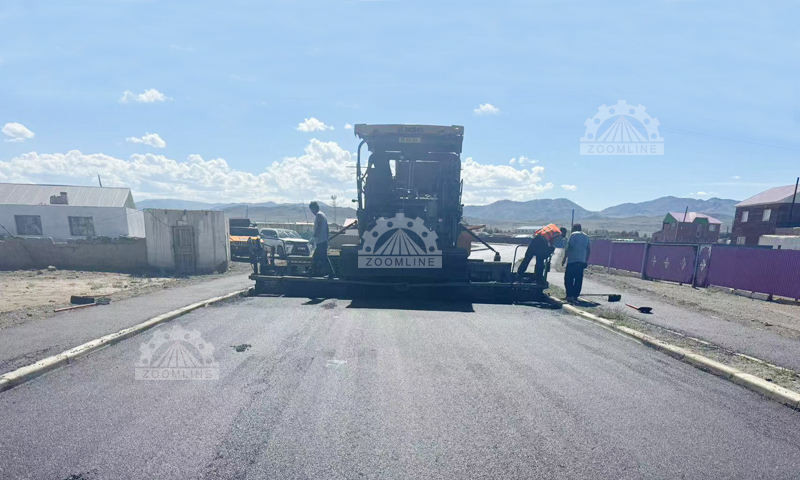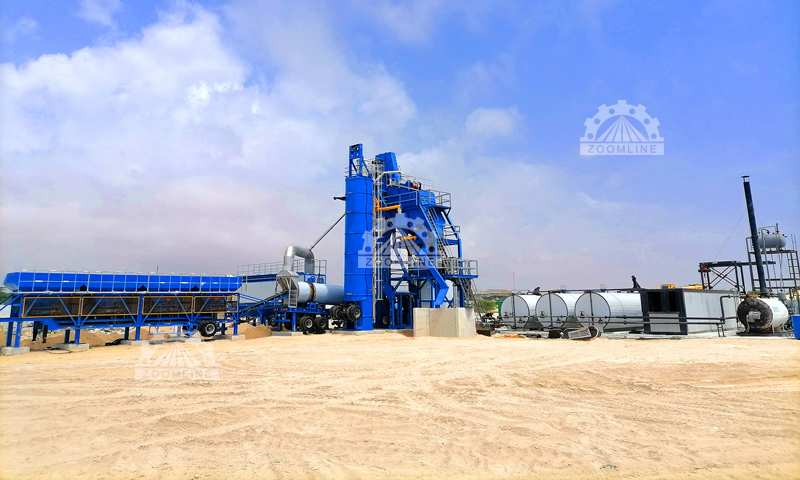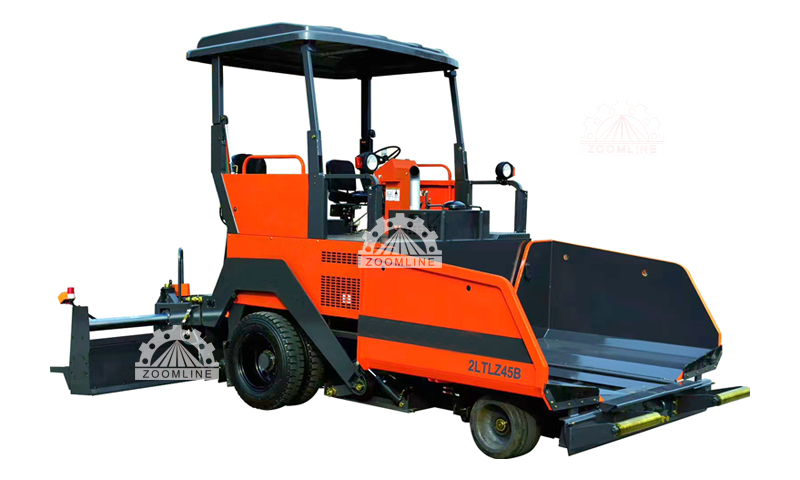Asphalt paving is a precise and systematic engineering process, with every stage from site preparation to final maintenance relying on specialized equipment. Whether for small-scale paving or large-scale highway construction, selecting the appropriate equipment directly determines the smoothness, durability, and service life of the pavement. This article will provide a detailed overview of the key equipment required for the entire asphalt paving process, helping you gain a comprehensive understanding of the technical nuances of this engineering endeavor.
Before understanding the specific equipment, it is crucial to first clarify the core steps of asphalt paving – each process requirement corresponds to a specific type of tool:
Site preparation stage: Use excavators and loaders to clear debris from the construction area to ensure no interference. Then use a grader to level the terrain, controlling the flatness to ±5 mm, and use a leveling instrument to measure the elevation, laying the foundation for subsequent construction.
Base course construction phase: Lay a base course of crushed stone or gravel in layers, each layer being 30-50 cm thick, with each layer not exceeding 20 cm in thickness. After laying, use heavy-duty vibrating rollers to compact the base according to the principle of ‘light first, then heavy; slow first, then fast’, rolling back and forth 4-6 times. Use the sand cone method to test the compaction degree, ensuring a compaction rate of ≥95% to establish a stable structural foundation.
Asphalt production stage: At a specialized asphalt mixing plant, precisely measure the coarse and fine aggregates (such as basalt and limestone) that have undergone screening treatment, along with road petroleum asphalt, according to the design requirements for the mix ratio. The mixture is uniformly blended in a forced-action mixer at high temperatures of 160-180°C, with mineral powder added to enhance adhesion and anti-stripping agents incorporated to improve the bond between asphalt and aggregate. After sampling and testing to ensure compliance with Marshall stability and flow value standards, the mixture is transported to the construction site;
Paving stage: Use an asphalt paver with an automatic leveling system, operating at a speed of 2-4 m/min, with multiple machines in a staggered formation, overlapping by 10-20 cm. Control temperature using an infrared thermometer (≥135°C), and use aluminum alloy guide beams and balance beams to ensure thickness and flatness within ±3 mm.
Compaction stage: Initial, intermediate, and final compaction. Initial compaction uses a 6-8t double-drum static roller for 1-2 passes (110-130°C); Intermediate compaction uses a 10-12t vibrating roller for 3-4 passes (90-110°C); Final compaction is performed using a rubber-wheeled roller for 1-2 passes to eliminate wheel marks (≥70°C), ensuring a compaction degree exceeding 97%.
Cooling and curing stage: The pavement is cooled to within ±5°C of ambient temperature and cured after wheel marks and softening have disappeared. Barriers are set up as warnings, and watering or covering with geotextile fabric is performed to promote hardening.
Quality inspection and maintenance: Core samples are taken to measure compaction degree and thickness, a smoothness meter is used to measure smoothness, and a deflection meter is used to measure bearing capacity. Non-compliant areas are milled and re-paved. Before opening to traffic, qualified road surfaces are sprayed with emulsified asphalt for sealing maintenance to delay aging.

Site preparation is the first step in asphalt paving and directly affects the stability of the subsequent pavement. The following equipment is required:
Excavators are the primary equipment for site clearance and are mainly used for removing vegetation, debris, and old pavement structures from the site; Grading the terrain according to the design slope to create conditions for base construction; Transporting earth and adjusting the site elevation to meet drainage requirements.
Graders are responsible for precise leveling during site preparation: Further leveling the ground after excavator grading using blades to ensure uniform slope; Optimizing surface drainage slopes to prevent water accumulation from eroding the base layer; Providing a smooth working surface for base material placement to ensure effective compaction.
Sweepers may seem simple, but they are crucial to pavement quality: Remove debris such as stones and dust from the site to prevent them from affecting the adhesion between asphalt and the base layer; Clear residual debris after milling the old pavement to prevent unevenness during compaction; Reduce dust pollution during construction and avoid safety hazards caused by flying debris.
The base serves as the ‘skeleton’ of the asphalt pavement, and its compaction quality relies on specialized equipment:
Base compaction primarily relies on rollers, which can be categorized based on construction requirements:
Static rollers: Utilize their own weight to compact base materials (gravel, crushed stone), suitable for initial leveling;
Vibrating rollers: Combine weight and vibration functions to transmit pressure to deeper layers, ensuring the subgrade meets density standards and preventing settlement later on.
The production and transportation of asphalt mix directly impact paving quality, with core equipment including:
Asphalt mixing plants serve as the ‘production facilities’ for asphalt mixtures, with primary types including:
Batch-type mixing plants: These plants use batch weighing and metering to precisely measure aggregates, asphalt, and other raw materials according to predefined mix designs, then mix them in a mixing drum. Its advantages include strict control over asphalt mixture quality, strong adaptability to raw materials, and the ability to adjust mix ratios on-demand, making it suitable for high-quality road construction projects such as highways and urban arterial roads. However, due to its batch production process, output is relatively low, and equipment investment and operational costs are higher.
Continuous-type mixing plants: In continuous-type mixing plants, aggregates, asphalt, and other raw materials are continuously fed into the mixing equipment for mixing. During production, the feed rates of each raw material are precisely controlled to ensure the mix ratio of the mixture. It has high production efficiency, can continuously and stably supply asphalt mixture, is suitable for large-scale road construction, and has a relatively simple equipment structure with lower investment costs. However, it has higher requirements for the stability of raw materials, and significant fluctuations in raw material quality may affect the quality of the mixture.
Mobile asphalt mixing plant: It has strong mobility and can be flexibly relocated according to changes in the construction site. The mixing equipment is integrated onto one or more movable chassis, enabling quick installation and disassembly. It is suitable for road maintenance or rural road construction projects that are far from fixed mixing plants, have small-scale and dispersed workloads, and can effectively reduce the transportation costs of asphalt mixture, but its production capacity is relatively limited.
Batch-type mixing plants: Produce mix in batches with precise mix ratio control, suitable for projects with high quality requirements;
Continuous-type mixing plants: Continuously mix aggregates with asphalt, offering high production efficiency, suitable for large-scale projects.

Dump trucks are responsible for safely transporting hot asphalt from the mixing plant to the construction site. Common types include:
Rear-dump trucks: Unload mixed materials by lifting the cargo box, offering simple operation and suitability for most scenarios;
Bottom-dump trucks: Unload materials via a bottom conveyor belt, reducing segregation of mixed materials and ensuring uniform quality;
Material Transfer Vehicles (MTVs): Can temporarily store and transfer mixed materials at the construction site, reducing paver waiting time and improving construction efficiency.
Paving is a critical step in determining road surface smoothness and relies on the following specialized tools:
The paver is the core equipment for the paving stage, with the following structure and functions:
Hopper: Stores the hot asphalt mixture transported to the site;
Conveying system: Transports the mixture from the hopper to the paving front;
Screed: Evenly spreads and preliminarily compacts the mixture, controlling pavement thickness and smoothness.
Depending on the operational scenario, pavers are categorized as:
Wheeled pavers: Highly maneuverable, suitable for narrow sites (e.g., residential roads, parking lots);
Track-type pavers: Stable and suitable for complex terrain, commonly used in large-scale projects such as highways.

Asphalt distributors are primarily used in specialized paving scenarios, such as overlay construction for old road maintenance, application of tack coat and prime coat, and installation of stress-absorbing layers. In preventive maintenance, it can uniformly spread emulsified asphalt on aged road surfaces to form a sealant layer and delay deterioration. During new road construction, it ensures the bond strength between the asphalt layer and the base layer by precisely controlling the spread volume. Its intelligent control system enables precise adjustment of spread width and thickness to adapt to different operational conditions:
Storing asphalt in onboard tanks and using spray bars to uniformly apply it to the base layer surface, enhancing the bond between the base layer and asphalt layer;
Suitable for tack coat and binder coat construction, or rapid paving requirements in large-scale commercial projects.

Compaction is a critical step in ensuring the durability of asphalt pavements, with the core equipment being:
Unlike base course rollers, asphalt rollers must adapt to the characteristics of hot asphalt:
Vibratory rollers: Eliminate air voids within the asphalt layer through high-frequency vibration to enhance density;
Static smooth-wheel rollers: rely on weight for final compaction, ensuring a smooth and flat surface and reducing rutting;
Tire rollers: utilize the elasticity of tires to compact asphalt, enhancing pavement sealing.
In addition to core construction equipment, the following tools are used for road rehabilitation, special environment construction, and post-construction maintenance:
Milling machines are essential for old road renovation:
They use rotating milling drums to cut old asphalt surfaces, allowing precise control of milling depth (surface profiling or full-depth milling);
Milling material is collected and recycled via conveyor belts, enabling resource reuse;
Equipped with a water spray system to reduce dust and temperature during milling, minimizing environmental pollution.
In low-temperature environments, asphalt heaters ensure construction quality:
Heats asphalt mixtures or base layers to maintain their plasticity, preventing paving difficulties caused by low temperatures.
Used for road surface cutting and edge processing:
Cuts old road surfaces to form neat edges, ensuring good connection between new asphalt and old road surfaces;
Cuts damaged areas during road repairs for precise repairs.
Sealcoating equipment is used for post-construction pavement maintenance:
Apply a sealant layer to the asphalt surface via spraying or scraping to resist UV radiation, moisture, and oxidation;
Extend pavement lifespan while improving pavement appearance.
The core advantages of using professional asphalt paving equipment include:
Superior quality: Intelligent leveling pavers control road surface flatness errors to within ±3 millimeters, while high-frequency, low-amplitude double steel wheel rollers achieve compaction rates exceeding 98%, reducing defects, improving load-bearing capacity, and extending road life.
Higher efficiency: Automated equipment integrated with GPS and automatic material feeding can operate 24/7, paving over 200 tons per hour, with efficiency improved by nearly 3 times. Intelligent monitoring optimizes parameters, shortens construction schedules, and reduces costs.
Greater durability: Asphalt plants precisely control temperature and mix ratios, standardized operations prevent process defects, ensuring road performance under heavy loads and reducing maintenance costs.
Greater safety: Equipment is equipped with multiple safety features, remote operation reduces personnel exposure risks, and noise and emissions meet standards, ensuring personnel health and environmental safety.
When investing in asphalt paving equipment, the following cost factors should be considered:
Brand and model: Well-known brands (such as Caterpillar and Volvo) are more expensive, but offer better reliability and residual value;
New vs. used: New equipment comes with warranties and the latest technology, while used equipment requires an assessment of its condition to avoid potential maintenance issues;
Specifications and features: Large equipment is suitable for commercial projects, while small equipment is suitable for residential applications; advanced features (such as GPS positioning and automatic control) enhance efficiency but increase costs.
For short-term projects, leasing is recommended (e.g., paver rental costs $3,000–6,000 per month);
Long-term operations should allocate maintenance costs (annual maintenance costs for large equipment range from approximately $5,000 to $20,000);
Prioritize equipment that can be recycled (e.g., milling machines) to reduce material costs.
From site clearance to final maintenance, each piece of equipment plays an irreplaceable role in the asphalt paving process. Selecting the right equipment, operating it properly, and maintaining it well not only ensures that the road surface meets quality standards but also extends its service life and reduces the total cost of ownership. Whether you are a contractor or a project manager, a thorough understanding of equipment characteristics and application scenarios is key to the successful completion of asphalt paving projects.
When undertaking a paving project, it is recommended to prioritize professional equipment and teams based on project scale, environmental conditions, and budget, ensuring that every inch of pavement withstands the test of time and traffic.